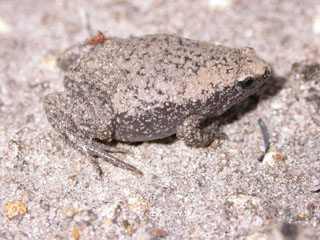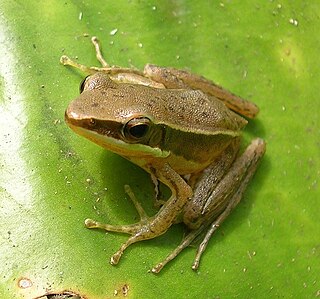
The Sturt National Park is a protected national park that is located in the arid far north-western corner of New South Wales, in eastern Australia. The 325,329-hectare (803,910-acre) national park is situated approximately 1,060 kilometres (660 mi) northwest of Sydney and the nearest town is Tibooburra, 6 kilometres (3.7 mi) away.

The marsh harriers are birds of prey of the harrier subfamily. They are medium-sized raptors and the largest and broadest-winged harriers. Most of them are associated with marshland and dense reedbeds. They are found almost worldwide, excluding only the Americas.

The true frogs, family Ranidae, have the widest distribution of any frog family. They are abundant throughout most of the world, occurring on all continents except Antarctica. The true frogs are present in North America, northern South America, Europe, Africa, and Asia. The Asian range extends across the East Indies to New Guinea and a single species has spread into the far north of Australia.

The common frog, also known as the European common frog, European common brown frog, European grass frog, or simply a frog, is a semi-aquatic amphibian of the family Ranidae, found throughout much of Europe as far north as Scandinavia and as far east as the Urals, except for most of Iberia, southern Italy, and the southern Balkans. The farthest west it can be found is Ireland, where it has long been thought, erroneously, to be an entirely introduced species. They are also found in Asia, and eastward to Japan.

The Hylidae are a wide-ranging family of frogs commonly referred to as "tree frogs and their allies". However, the hylids include a diversity of frog species, many of which do not live in trees, but are terrestrial or semiaquatic.

The Microhylidae, commonly known as narrow-mouthed frogs, are a geographically widespread family of frogs. The 584 species are in 61 genera and 11 subfamilies, which is the largest number of genera of any frog family.

Rana is a genus of frogs commonly known as the Holarctic true frogs, pond frogs or brown frogs. Members of this genus are found through much of Eurasia, North America, Central America, and the northern half of South America. Many other genera were formerly included here.
These true frogs are usually largish species characterized by their slim waists and wrinkled skin; many have thin ridges running along their backs, but they generally lack "warts" as in typical toads. They are excellent jumpers due to their long, slender legs. The typical webbing found on their hind feet allows for easy movement through water. Coloration is mostly greens and browns above, with darker and yellowish spots.

Papurana daemeli is a species of "true frog", family Ranidae. It is found in New Guinea, northern Australia, and some smaller islands. It is the only ranid frog found in Australia. In Australia, the species is restricted to the rainforest of northern Queensland and the eastern border of Arnhem Land, in the Northern Territory. In Australia, it is usually known as wood frog or sometimes as water frog. Other vernacular names are Australian wood frog, Australian bullfrog, and Arnhem rana.

The Sedgwick County Zoo is an AZA-accredited wildlife park and major attraction in Wichita, Kansas. Founded in 1971 with the help of the Sedgwick County Zoological Society, the zoo has quickly become recognized both nationally and internationally for its support of conservation programs and successful breeding of rare and endangered species. Having over 2,500 animals of nearly 500 different species, the zoo has slowly increased its visitors and now ranks as the number one outdoor tourist attraction in the state.

The Australian green tree frog, simply green tree frog in Australia, White's tree frog, or dumpy tree frog, is a species of tree frog native to Australia and New Guinea, with introduced populations in the United States and New Zealand, though the latter is believed to have died out. The species belongs to the genus Litoria. It is morphologically similar to some other members of the genus, particularly the magnificent tree frog (L. splendida) and the white-lipped tree frog (L. infrafrenata).
Bullfrog is a common English language term to refer to large, aggressive frogs, regardless of species.

The family Prostomidae is a small group of beetles with no vernacular common name, though recent authors have coined the name jugular-horned beetles. They are often found in dead wood. The family consist of two genera with about 20 species. Prostomis mandibularis is known from North America. Other species of Prostomis are found in Africa, the Pacific region and East Asia. Species of Dryocora are known from New Zealand, Australia and Tasmania.

The San Antonio Zoo is an Association of Zoos and Aquariums-accredited zoo in Midtown San Antonio, Texas, United States. It is located in the city's Brackenridge Park. The 35-acre (14 ha) zoo has a collection of over 3,500 animals representing 750 species. The zoo's annual attendance exceeds 1,000,000. It also runs non-animal attractions, such as the 2 ft narrow gauge San Antonio Zoo Eagle train ride, which first opened in 1956 and utilizes three Chance Rides C.P. Huntington locomotives.

There are more than 2000 species of fauna that can be found in Tamil Nadu. This rich wildlife is attributed to the diverse relief features as well as favorable climate and vegetation in the Indian state. Recognizing the state's role in preserving the current environment, the government has established several wildlife and bird sanctuaries as well as national parks, which entail stringent protective measures. Tamil Nadu is also included in the International Network of Biosphere Reserves, which facilitates international recognition and additional funding. Currently, there are five national parks and 17 sanctuaries that serve as homes to the wildlife.

A tree frog is any species of frog that spends a major portion of its lifespan in trees, known as an arboreal state. Several lineages of frogs among the Neobatrachia have given rise to tree frogs, although they are not closely related to each other.

The Hylinae are the largest of three subfamilies of Hylidae, the "tree frogs". It contains nearly 700 species in 41 genera. They are generally found in North and South America, Europe, temperate Asia, and Africa north of the Sahara.

Hylarana, commonly known as golden-backed frogs, is a widespread genus of true frogs found in tropical Africa, Asia, and Australia. It includes around 84 to 96 valid species.

















